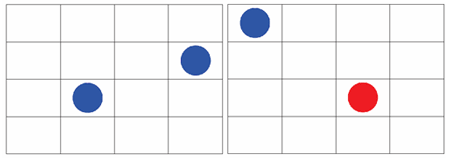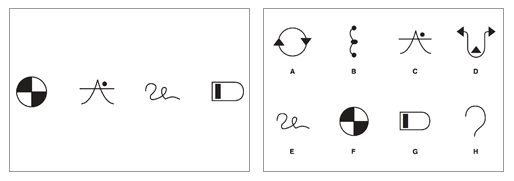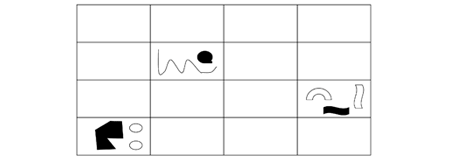Wechsler Memory Scale | Fourth Edition
WMS-IV- Wechsler Memory Scale® Fourth Edition (WMS®-IV) is the most widely used scale of adult memory. In response to changing demographics, increased caseload, and new research and clinical needs, this latest edition of the memory test includes four new subtests and modifications to three existing subtests. Eight subtests have also been eliminated. Guidance on using this test in your telepractice.
Choose from our products
-
Kits
Starter & complete kits, print & digital
21 options
from $382.80 -
Test forms & reports
Booklets, record forms, answer sheets, report usages & subscriptions
15 options
from $3.60 -
Support materials
Manuals, stimulus books, replacement items & other materials
12 options
from $22.10 -
Training
Onsite, virtual & on-demand trainings
1 option
from $2.90 -
All products
All tests & materials offered for WMS-IV
45 options
from $2.90
-
WMS-IV Complete Kit in Box
774756306 Qualification Level CIncludes Administration and Scoring Manual, Technical Manual, Stimulus Book #1, Stimulus Book #2, 25 Adult Record Forms, 25 Older Adult Record Forms, 25 Response Booklets, Design and Spatial Addition Card Set, Scoring Template, and Memory Grid
-
WMS-IV Complete Kit in Box with Report Writer
774756470 Qualification Level CIncludes items from 774756306, plus WMS-IV Report Writer
-
WMS-IV Complete Kit in Soft Case with Report Writer
774756772 Qualification Level CIncludes items from 774756306, plus WMS-IV Report Writer in a soft case
-
WMS-IV Complete Kit in Box with Scoring Assistant
774756292 Qualification Level CIncludes Administration and Scoring Manual, Technical Manual, Stimulus Book #1, Stimulus Book #2, 25 Adult Record Forms, 25 Older Adult Record Forms, 25 Response Booklets, Design and Spatial Addition Card Set, Scoring Template, Memory Grid, and scoring software
Estimated to ship:6 weeks -
WMS-IV Complete Kit in Soft Case with Scoring Assistant
774756764 Qualification Level AIncludes items from 774756306, plus Scoring Assistant in soft case
-
WMS-IV Flexible Approach Kit (Print)
0158896300 Qualification Level CIncludes 25 WMS-IV Flexible Approach Record Forms (Print), 25 WMS-IV Supplemental Record Forms (Print), WMS-IV Supplemental Stimulus Book (Print), and Electronic Administration and Norms Manual on CD
-
WAIS-IV-CDN-WMS-IV Combination Kit in Hard-Soft Case with Report Writer
774756497 Qualification Level CIncludes report writer, complete WMS-IV kit in soft case, and complete WAIS-IV CDN kit in hard case
-
WAIS-IV-CDN-WMS-IV Report Writer Combination Package
774756888 Qualification Level C -
WAIS-IV-CDN-WMS-IV Scoring Assistant Combination Package
774756896 Qualification Level C -
WAIS-IV-CDN-WMS-IV Combination Kit in Soft Case with Report Writer
774756756 Qualification Level A -
WAIS-IV-CDN-WMS-IV Combination Kit in Box with Scoring Assistant
774756314 Qualification Level C -
WAIS-IV-CDN-WMS-IV Combination Kit in Hard-Soft Case with Scoring Assistant
774756322 Qualification Level CIncludes scoring assistant, complete WMS-IV kit in soft case, and complete WAIS-IV CDN kit in hard case
-
WAIS-IV-CDN-WMS-IV Combination Kit in Soft Case with Scoring Assistant
774756330 Qualification Level C -
WAIS-IV-CDN-WMS-IV-ACS Combination Basic Kit in Hard-Soft Case-Box
774759763 Qualification Level C -
WAIS-IV-CDN-WMS-IV-ACS Combination Basic Kit in Soft Cases-Box
774759771 Qualification Level C -
WAIS-IV-CDN-WMS-IV-ACS Combination Kit in Soft Cases-Box with Report Writer for WAIS-IV-CDN-WMS-IV
774759836 Qualification Level C -
WAIS-IV-CDN-WMS-IV-ACS Combination Kit in Hard-Soft Cases-Box with Scoring Assistant for WAIS-IV-CDN-WMS-IV
774759798 Qualification Level C -
WAIS-IV-CDN-WMS-IV-ACS Combination Kit in Soft Cases-Box with Scoring Assistant for WAIS-IV-CDN-WMS-IV
774759801 Qualification Level C -
WMS IV-ACS Combination Kit in Boxes with Report Writer for WMS IV
774759976 Qualification Level C -
WMS IV-ACS Combination Kit in Soft Case-Box with Report Writer for WMS IV
774759984 Qualification Level C -
WMS IV-ACS Combination Kit in Boxes with Scoring Assistant for WMS IV
077475995X Qualification Level C -
WMS-IV Technical Manual (Print)
0158895827 Qualification Level C -
WMS-IV Flexible Approach Q-global Manual and Alternate Indexes Worksheet (Digital)
A103000231415 Qualification Level COnce ordered, the digital asset is accessible by logging into Q-global and visiting the Q-global Resource Library. It is a downloadable file.
-
WMS-IV Q-global Administration and Scoring Manual (Digital)
A103000231399 Qualification Level COnce ordered, the digital asset is accessible by logging into Q-global and visiting the Q-global Resource Library. It is a view-only digital file.
-
WMS-IV Q-global Technical and Interpretive Manual (Digital)
A103000231398 Qualification Level COnce ordered, the digital asset is accessible by logging into Q-global and visiting the Q-global Resource Library. It is a view-only digital file.
-
WMS-IV Administration and Scoring Manual (Print)
0158895819 Qualification Level CEstimated to ship:6 weeks -
WMS-IV Stimulus Book 1 (Print)
0158895835 Qualification Level CIncludes Brief Cognitive Status Exam, Visual Reproduction I, Logical Memory I and Spatial Addition
Estimated to ship:3 weeks -
WMS-IV Stimulus Book 2 (Print)
0158895843 Qualification Level CIncludes Visual Reproduction II, Logical Memory II, Verbal Paired Associates I, Designs I, Symbol Span, Verbal Paired Associates II and Designs II
-
WMS-IV Q-global Stimulus Book 1 and Administration Directions (Digital)
A103000231412 Qualification Level CIncludes Brief Cognitive Status Exam, Visual Reproduction I, Logical Memory I and Spatial Addition. Once ordered, the digital assets are accessible by logging into Q-global and visiting the Q-global Resource Library. The stimulus book is a view-only digital file; the administration directions are downloadable.
-
WMS-IV Q-global Stimulus Book 2 and Administration Directions (Digital)
A103000231413 Qualification Level CIncludes Visual Reproduction II, Logical Memory II, Verbal Paired Associates I, Designs I, Symbol Span, Verbal Paired Associates II and Designs II. Once ordered, the digital assets are accessible by logging into Q-global and visiting the Q-global Resource Library. The stimulus book is a view-only digital file; the administration directions are downloadable.
-
WMS-IV Scoring Assistant (Digital)
0158896017 Qualification Level CIncludes 1 CD-ROM with unlimited scoring
-
WMS-IV Report Writer (Digital)
0158896092 Qualification Level CIncludes 1 CD-ROM with unlimited scoring with interpretive narrative
-
WAIS-IV-CDN-WMS-IV Scoring Assistant Upgrade to Report Writer Combination Package
077475687X Qualification Level C -
WMS-IV Flexible Approach Record Forms Qty 25 (Print)
0158896319 Qualification Level CSupports LMVR Battery
Estimated to ship:3 weeks -
WMS-IV Adult Ages 16-69 Record Forms Qty 25 (Print)
0158895851 Qualification Level C -
WMS-IV Older Adult Ages 65-90 Record Forms Qty 25 (Print)
015889586X Qualification Level C -
WMS-IV Flexible Approach Supplemental Record Forms Qty 25 (Print)
0158896327 Qualification Level CSupports VRLO and LONA Batteries
Estimated to ship:6 weeks -
WMS-IV Q-global Remote-Adapted Response Booklet (Digital)
A103000231404 Qualification Level COnce ordered, the digital asset is accessible by logging into Q-global and visiting the Q-global Resource Library. It is a downloadable file.
-
WMS-IV Response Booklets Qty 25 (Print)
0158895908 Qualification Level C -
Memory Grid (Print)
0158234472 Qualification Level CIncludes 2011 Memory Grid update for NEPSY-II and WMS-IV
Estimated to ship:3 weeks -
WMS-IV Complete Card Set (Print)
0158895932 Qualification Level CIncludes 8 Design Cards Set A, 12 Design Cards Set B, 12 Design Cards Set C, 16 Design Cards Set D, 2 Design Cards Teaching Examples, and 16 Spatial Addition cards
-
WMS-IV Training CD (Digital)
0158896289 Qualification Level CIncludes WMS-IV Training on administration, scoring and interpretation on 1 CD-ROM
Estimated to ship:6 weeks -
WMS-IV Q-global Score Report Qty 1 (Digital)
0150014562 Qualification Level C -
WMS-IV Flexible Approach Q-global Stimulus Book and Administration Directions (Digital)
A103000231414 Qualification Level COnce ordered, the digital assets are accessible by logging into Q-global and visiting the Q-global Resource Library. The stimulus book is a view-only digital file; the administration directions are downloadable.
-
WMS-IV Q-global Scoring Subscription 1 Year (Digital)
QG1WM4 Qualification Level CIncludes unlimited scoring per user within an account
Overview
- Publication date:
- 2009
- Age range:
- 16:0 to 90.11 years
- Scores/Interpretation:
- Contrast Scores
- Qualification level:
- C
- Telepractice:
- Guidance on using this test in your telepractice
Product Details
|
The WMS-IV was developed to provide the most trustworthy, advanced measure of memory and results for addressing the changing clinical landscape. Benefits
FeaturesSignificant changes have been made to the WMS-IV based on individual client needs and examiner preferences.
|
|
New Subtests |
|
Spatial AdditionClients must remember location of dots on two separate pages, add or subtract locations, and hold and manipulate visual spatial information. |
Symbol SpanClients are asked to remember the design and the left to right sequence of the design, then select the correct design from foils and choose them in the correct sequence. |
Design MemoryDesign Memory evaluates immediate and delayed recall as well as delayed recognition. It does not include drawing and reduces the opportunity to guess the correct response. |
WMS-IV Flexible Approach Batteries |
Standard WMS-IVThis consists of the 7 primary subtests that comprise the full WMS-IV battery and provide coverage for all the memory indexes. |
LMVR and LMDELMVR, consists of Logical Memory (LM) and Visual Reproduction (VR), and LMDE consists of Logical Memory and Designs (DE). |
VRLO and LONAThis set of alternate batteries focuses on using supplemental subtests for assessing visual memory, which is a difficult construct to measure. |
OAAThe OAA battery was developed in the standard WMS-IV as a shorter battery for use with older adults ages 65 to 90. |
|
LMDE and OAA batteries can be collected using standard WMS-IV record forms and an accompanying worksheet provided in the WMS-IV Flexible Manual. Sample ReportsScores are now derived for Older Adult Battery (65–90) and Adult Battery (16–69). Index scores include: Auditory Memory, Visual Memory, Visual Working Memory, Immediate Memory, and Delayed Memory. New contrast scores provide information on clinical significance of changes in scores across subtests or indexes. The following scoring information and samples are available for WMS-IV. |
Resources
|
The following resources are available for WMS-IV. Product Overview |
Case Studies & Research |
Q-interactive
WMS-IV on Q-interactive at a Glance:Scoring and Reporting
Materials Needed Benefits of WMS-IV on Q-interactive
How Can I Buy WMS-IV on Q-interactive?New customers:Annual Q-interactive licenses can be purchased using our online order form or by calling Customer Support at 1-866-335-8418. See the Q-interactive license options for more information on pricing. Current Q-interactive customers:If you want to add the WMS to your account, visit our online order form and select the "Add test(s) to existing account" option. You may also call Customer Support at 1-866-335-8418. |
FAQs
|
Frequently asked questions follow. Click on a question to see the response.
|
Webinars
|
The following training events are available for WMS-IV. |

Get it with the Digital Assessment Library!
K-12 districts get unlimited access to a library of over 40 digital assessments for a simple, annual price based on student enrollment




